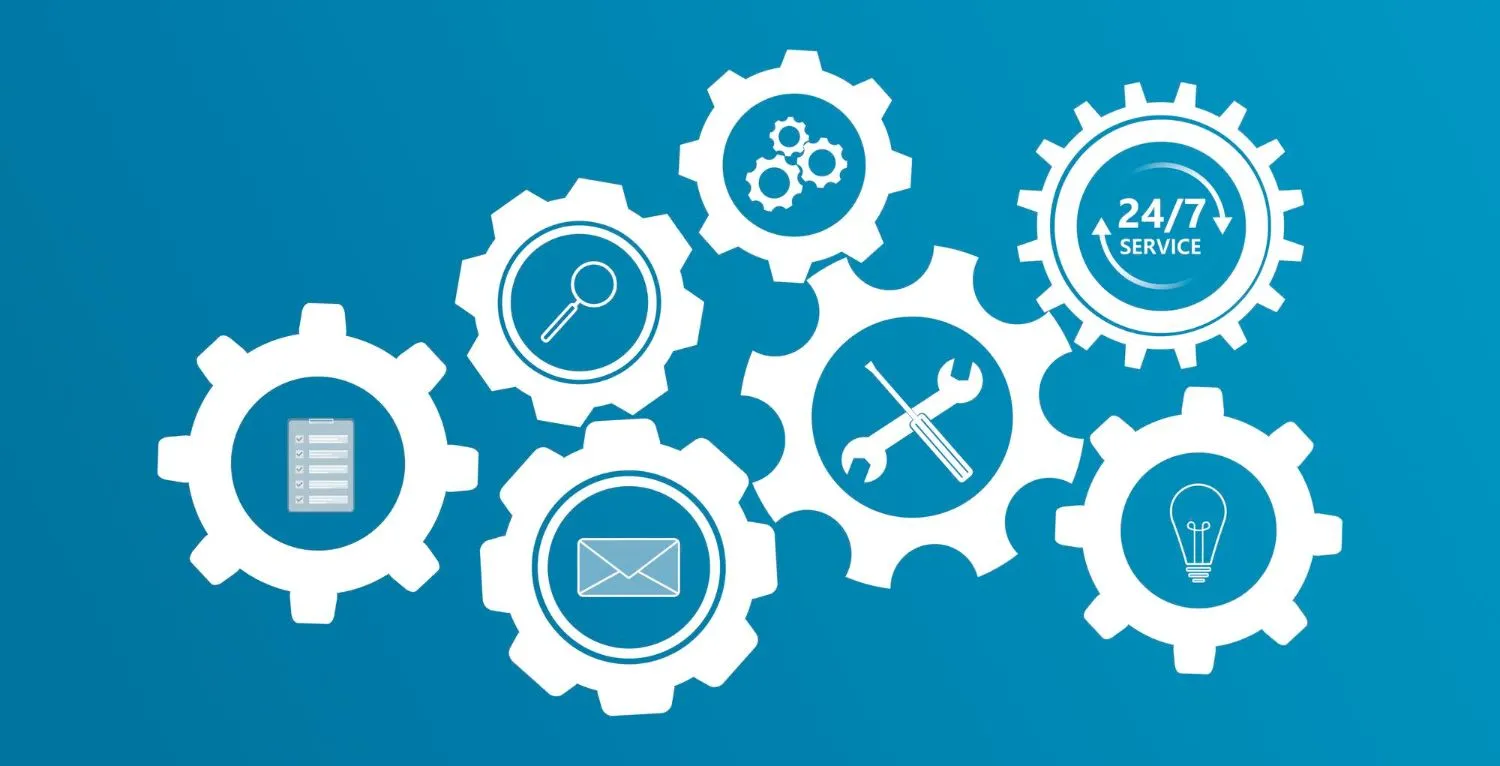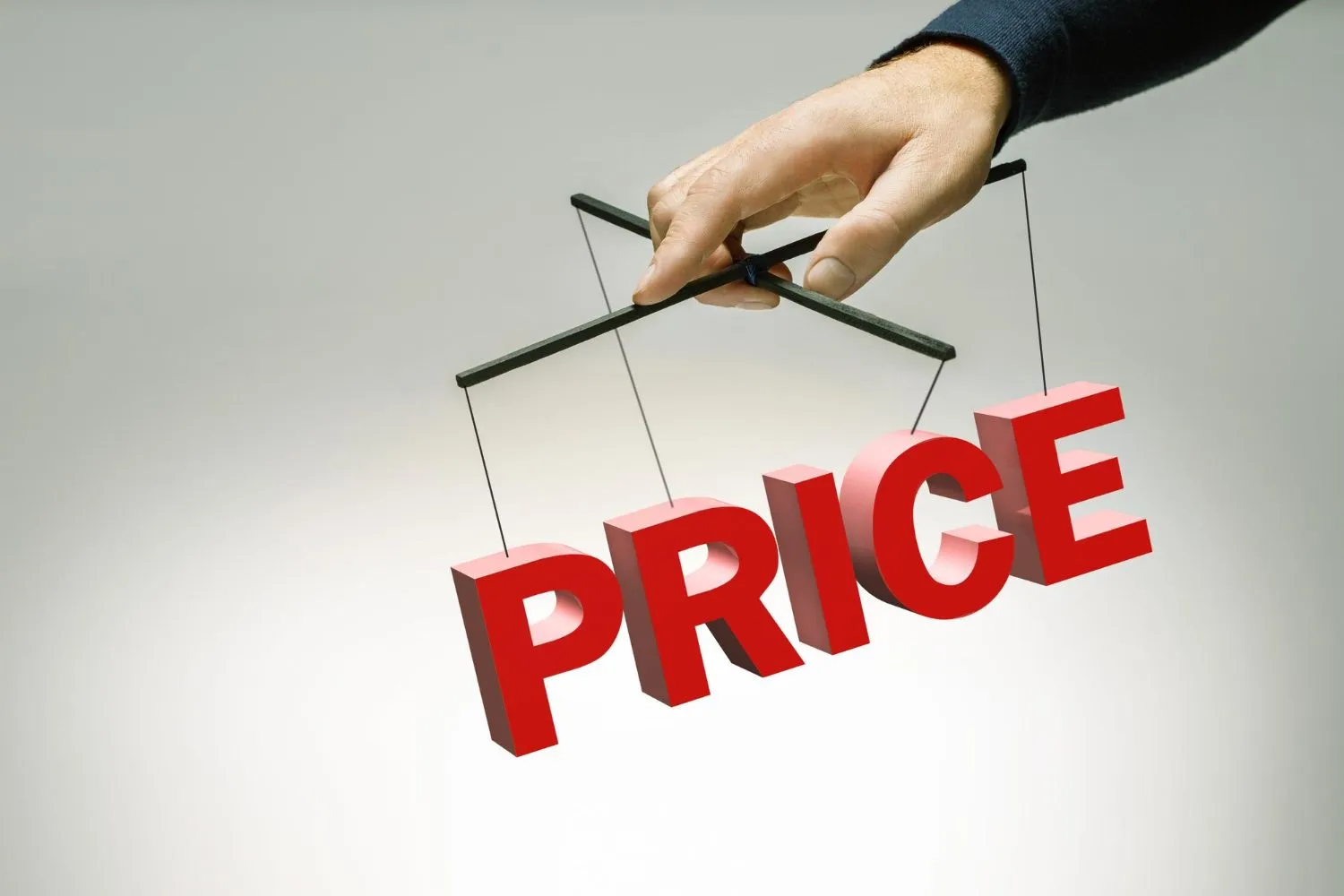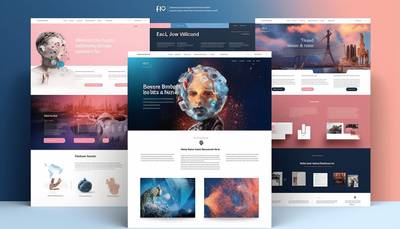Website costs range from PLN 3,000 to PLN 12,000. This is a large range resulting from the diversity of implemented projects. "One page" websites range around PLN 1,000-3,000, while the cost of a website for a medium-sized company exceeds PLN 10,000.
There are also websites on the market made for PLN 800, as well as projects costing tens of thousands of zlotys. In this article, I will try to explain what the cost of a website depends on and what is worth paying attention to when deciding on such an expense.
What constitutes the cost of a website?
Creating a website is a process that includes many stages and components, from graphic design to optimization and technical support. The price of a website depends on many factors, including its type, functionality, technologies used, and whether it is an individual project or based on a ready-made template.

Graphic design
The appearance of the website is the first thing the user notices. Graphic design must not only attract the eye, but also reflect the character of the brand and facilitate navigation. The cost of a graphic design may vary depending on whether we choose a ready-made template or a unique design created from scratch by a graphic designer.
Please remember that each of these choices is correct, but not the same will work for everyone. Template-based websites are good for companies that are just starting out and don't have very limited funds. A medium side is better than no side. Ultimately, however, you must remember that an individual brand image allows you to stand out, and the website should address the specific problems of your customers.
Technologies and platforms
The choice of technology and platforms on which the website will be built significantly affects the costs. Websites built on popular CMS content management systems are usually cheaper to implement than those that require custom programming solutions.
However, we live in times of development of artificial intelligence and competition for attention. Closed solutions often have limited integration options with automation systems. And websites based on CMS systems often load quite slowly. You must know that if the user does not receive information from you immediately, he will go to the company that will provide him with this information.
Functionalities and integrations
The more functionalities and integrations with external systems (e.g. payment systems, reservations, CRM) a website has, the higher its price. Each additional function, such as a contact form, photo gallery or blog, requires additional work, which translates into the final cost.
SEO and Content on the website
Optimizing your website for search engines is crucial for your online visibility. SEO is not a one-time action, but a process that includes both technical optimization of the website and the creation of valuable content. SEO costs may vary, depending on the scope of work.
The content of the website, i.e. texts, photos and videos, is its heart. Professional content not only informs users, but also builds trust in the brand. The cost of creating content depends on its quantity, quality and whether professional photos or videos are needed.
Hosting, domain and maintenance
For a website to be available on the Internet, it must be located on a server (hosting) and have its own domain. Annual hosting and domain costs are usually fixed, although they may vary depending on the service provider you choose and the server resources needed.
Websites require regular updates and monitoring to ensure their security and continuous operation. Maintenance costs may include software updates, data backup and technical support.
How much time does the company spend on the project?
According to the HubSpot article: How long does it take to build a website , just preparing and determining the graphic design along with "coding" can take at least 6 weeks. In our experience, an active attitude on the part of the client can shorten this time by about 2.5 weeks. Significant delays are generated by communication between the client and the contractor.
However, this is a more physical phase. Before starting cooperation, however, it is necessary to understand the specific nature of the client's industry and its target group. Then you need to prepare a general idea for the project, and all this takes time, which in turn translates into costs.
On the other hand, there is still programming work, such as installing the website on the server, which must be properly configured for this purpose, and testing whether all elements on the website are working properly. For projects with a content management system, it is also necessary to train the client in how to use the system.
How does this affect costs?
To make the calculations, you need to make certain assumptions about the company's costs. The employees necessary to create a website are a designer, a programmer and a person responsible for business analysis and often for creating content.
According to the IT earnings report prepared by Bulldogjob , a programmer earns on average PLN 9,754, a business analyst - PLN 8,525 and a designer (UX/UI) - PLN 8,095. Therefore, just to pay employees' salaries requires the company's revenue to exceed PLN 26,000 per month. Therefore, if you were to develop a website for a medium-sized company for PLN 5,000 net, it would be necessary to complete over 5 projects per month. The research cited in the previous section clearly shows that creating a valuable website takes a while longer.
Of course, there is nothing wrong with choosing a website with several subpages and prepared content for PLN 3,000. However, you must be aware that it will not be a product of particular quality. Unfortunately, companies often promise golden mountains, and we often find out what it looks like in practice too late.
How does site type affect price?
The type of website is one of the main factors influencing its price. Different types of websites require different resources, technology and work time, which directly translates into costs. Below you will find how individual types of pages may affect the price, presenting the approximate costs associated with their implementation.

Website Business card
A business card website is the simplest type of website, usually consisting of one to several subpages. It is mainly used to present the company, its offer and contact details. Due to its simplicity, the costs are the lowest, and the implementation may range from PLN 500 to PLN 4,000, depending on the design and necessary functionalities.
One Page
A One Page is a one-page presentation in which all information is placed on one scrolling page. The costs of such a page are comparable to a showcase page, but may be slightly higher on the lower end due to the need to design fluid navigation and sections. The price range is usually from PLN 1,000 to PLN 3,000.
Blog page
A blog requires a content management system (CMS) to publish and archive posts. Costs may be higher due to the need to implement additional functions, such as a comment system or post categories. As a guide, the cost of a blog starts from PLN 2,000 and may increase depending on the design and integration and functionality provided.
Company site
Company websites are more complex and may contain many subpages with an offer, information about the company, a blog, and contact forms. The costs of such a website start from PLN 3,000 and may increase depending on the amount of content, integration with external systems and the level of project advancement. Most often, for a medium-sized company, the cost ranges from PLN 3,000 to PLN 14,000.
Online shop
Online stores are the most complex projects, requiring payment systems, product management, shopping cart and transaction security. Costs start from PLN 5,000 for simple solutions, but may exceed PLN 20,000 for stores with a wide range of products and advanced functionalities.
Dedicated website
Dedicated websites, created to order with unique functionalities, are the most expensive. Their price depends on the scope of the project and can start from several thousand zlotys, and in the case of very advanced projects even exceed PLN 50,000.
To summarize, the type of website has a direct impact on the price of the project. Costs increase with the complexity of the website and the number of functionalities required. It is important to precisely define your needs and expectations at the planning stage, which will allow you to better understand the expected costs.
How much does it cost to maintain a website?
Maintenance costs may vary depending on many factors, but most often budget solutions start from PLN 300 per month after taking into account all costs.

Hosting
Hosting is the server space on which the website is located. Its cost depends on the required computing power, disk capacity and additional services, such as encrypted connections or backups. For simple websites, the cost of hosting may start from several dozen zlotys per year, while in most projects it will cost several hundred zlotys per year (often PLN 60 per month is enough).
Domain
The cost of maintaining a domain usually ranges from several dozen to several hundred zlotys per year and depends on its popularity and domain extension (e.g. .com, .pl, .io).
The cost of a pl domain is approximately PLN 10 for registration for the first year and PLN 50-60 for renewal for the next year. In the case of a com domain, registration and renewal costs are similar and range from PLN 50-60.
SSL certificate
An SSL certificate ensures a secure connection between the website and its user. It is an essential element of every professional website, especially those that process personal data or financial transactions. The cost of an SSL certificate starts at around PLN 100 per year, although many hosting companies offer it for free as part of their package.
Updates and support
Regular updates of the content management system (CMS), plugins and themes are necessary for the security and proper functioning of the website. Depending on the contract with the contractor, the costs of updates and technical support may be included in the initial cost of the website or billed separately. Technical support and updates can cost from a thousand to several thousand zlotys per year, depending on the complexity of the website and the speed of required responses.
SEO positioning and optimization
For a website to be visible in search results, it must be positioned and optimized for SEO on an ongoing basis. These costs may vary significantly depending on the industry, the competitiveness of phrases and the scope of activities, ranging from several hundred to even several thousand zlotys per month.
The costs of maintaining a website can therefore vary greatly and depend on many factors. It is important to clearly define your needs and expectations before starting the project, which will allow you to better understand the potential costs. Regular website maintenance not only ensures its stable and secure operation, but also contributes to better online visibility.
Is it worth investing in cheap websites?
Investing in a website is an important decision for every company. While at first glance, cheap websites may seem an attractive option due to their low initial cost, it is important to understand the long-term consequences of this choice.

Cost and value perspective
Cheap websites are often attractively priced because they are based on ready-made templates with limited customization options. They may appear online quickly, but they usually offer less functionality and weaker SEO optimization. This means they may not be as effective at driving web traffic or conversions as pages designed and optimized by professionals.
Quality and image
A website is often the first point of contact of a potential customer with a brand. Cheap websites may not present your company in the best light, which can impact first impressions and perceptions of brand value. A high-quality website, designed with the user in mind, not only attracts more attention, but also builds trust and a professional image of the company.
Development and scalability
Websites should grow with your business. Low-cost solutions may prove limited when a company wants to introduce new features, integrations or customizations. Professionally designed websites are usually more flexible and can be expanded more easily, which translates into a better long-term investment.
Safety and support
Cheap sites may not offer the same level of security and technical support, which can put your business at risk of cyber attacks. Professional agencies often offer ongoing support and software updates, which is crucial to maintaining the security and uptime of your website.
Good for a start
However, cheap solutions are good for starting a company. They allow you to quickly appear online without requiring large financial outlays. Companies that do not yet know whether their business will succeed can confidently decide on such a solution. However, you must remember that at some point a change will be necessary and that a cheap website is not for people who rely on acquiring customers from the Internet.
What are the most common settlement methods?
Settlements for the creation of a website may take various forms, adapted to the specific nature of the project and the client's preferences. It is important to understand the available options in order to choose the model that best suits both the client's expectations and the contractor's capabilities.
- Hourly rate - is calculated based on the number of working hours devoted to the project. This model allows for flexible management of working time, but requires careful monitoring of progress and working time by the contractor.
- Fixed price for the project - it is agreed at the very beginning of cooperation and covers all work on the project. Thanks to this, the client is clear about the costs associated with developing the website, which facilitates budget planning.
- Settlement for individual stages of the project - the project is divided into stages, and the client settles accounts with the contractor for each completed stage. This form of cooperation allows for greater control over the course of work and the budget.
- Subscription - the customer pays a regular, monthly or annual subscription fee for support, updates and possible modifications to the website. This model is particularly beneficial for projects that require constant maintenance and updating.
- Exchange of services (barter) - a less formal method of settlement, which may be beneficial when the contractor is interested in the services offered by the client.
In the context of a website development contract, it is also important to precisely define the terms of cooperation, including the transfer of copyrights and licenses, as well as to regulate issues such as a non-competition clause or the possibility of using the project in the contractor's portfolio.
Additional functionalities and their impact on the price
When deciding to build a website, it is worth considering what additional functionalities will be needed to achieve business goals. Each additional function affects the final price of the project.

Content Management System (CMS)
Implementing a content management system allows you to easily add, edit and delete content on the website without the need for programmer intervention. Choosing popular solutions may slightly increase the initial cost, but allows easier and cheaper further operation of the website.
Website responsiveness
Adapting a website to be displayed on various devices (computers, smartphones, tablets) is a standard today. Designing a website with responsiveness in mind may slightly increase its cost, but it is an investment that improves accessibility and usability of the website, which translates into a better user experience.
External integrations
Integration of the website with external systems, such as payment systems, CRM or social media, can significantly affect the price. The cost of such integrations depends on their complexity and quantity, as well as on whether ready-made solutions are available or require individual coding.
Interactive elements and multimedia
Introducing advanced interactive elements to your website, such as animations, calculators, and photo and video galleries, can increase visitor engagement. The cost of such add-ons depends on their complexity and whether ready-made solutions are used or require individual design and coding. In the case of complex tools, prices can run into thousands of zlotys.
Additional costs generated by CMS
License costs
Some CMSs, especially commercial ones, require a license fee. These costs may be one-time or recurring, depending on the terms offered by the provider.
Extensions and plugins
Most CMSs offer basic functionalities that can be extended using add-ons and plug-ins. These tools can be both free and paid. The costs of plugins, especially specialized ones, can significantly increase the initial budget for a website.
Individual modifications
Customizing the CMS to individual needs may require the work of a programmer, which involves additional costs. Non-standard functionalities or external integrations can significantly increase the final price of the project.
Updates and maintenance
CMS systems require regular updates, both of the platform itself and of the installed plugins. Updates are crucial for security, but their implementation may require specialist help, which generates additional costs.
Training and support
Managing content on the website may require user training. Some companies offer paid training and technical support to help you use your CMS effectively.
SEO and optimization
Although many CMSs are SEO-friendly, search engine optimization often requires installing additional plugins or modifying the code. Professional SEO services are necessary for website visibility, but they are another cost.
Choosing a CMS is an important decision that affects the functionality, ease of content management and website maintenance costs. It is worth carefully considering all available options to choose the solution that best suits your needs and financial possibilities.
Additional services related to the website

SEO optimization
Optimizing your website for search engines is necessary for its visibility. SEO services include keyword analysis, content optimization, improving page loading speed and building internal and external linking strategies. These actions help improve the website's position in search results.
Content management
Regularly publishing valuable content is important for user engagement and SEO. Content management services may include creating a blog, industry articles, guides, or content for product pages. Creating and updating content professionally takes time and skill.
Social media marketing
Being present on social media makes it easier to build relationships with customers and increases website traffic. Social media marketing services may include managing profiles, creating and publishing posts, and running advertising campaigns.
Analysis and reporting
Understanding how users use the website allows for optimization and better adaptation to the needs of the recipients. Analytical and reporting services include website traffic analysis, conversion tracking, and monitoring of user behavior, which allows for continuous improvement of the website.
Site security
Ensuring the security of the site and user data is essential. Security services may include regular backups, software updates, malware and hacker protection, and SSL certificates.
Technical assistance
Ongoing technical support ensures that any technical problems or questions will be resolved quickly. This may include help with CMS management, troubleshooting hosting issues, or website updates.
Integration with other programs
Integrating a website with other programs can significantly expand the functionality and improve the experience of website users. This is a process that allows you to seamlessly connect the website with external services and applications, such as payment systems, customer relationship management (CRM) tools, e-commerce platforms or social media. Here's how integration with various programs affects the site and its users.
Payment systems
Integration with payment systems such as PayPal, Stripe or Przelewy24 is necessary for websites offering online sales of products or services. It enables quick and safe transactions, which is beneficial for both the website owner and customers.
CRM tools
Integration of the website with customer relationship management tools, such as Salesforce or HubSpot, allows for automatic collection of data about customers and their behavior. This makes it possible to better tailor the offer to users' needs and manage contacts more effectively.
What should you pay attention to when choosing a website contractor?
Choosing the right website contractor is a decision that can have a major impact on the success of your project. There are several key aspects that are worth considering to make sure your choice is the right one.

Experience and portfolio
One of the first elements you should look at is the company or freelancer's experience in creating websites. Browse their portfolio to see examples of previously completed projects. A portfolio can give you an idea of the style, quality and variety of work, as well as show whether the contractor has experience with projects similar to yours.
Opinions and references
Opinions from previous customers can provide valuable information about working with a given contractor. Look for reviews on the contractor's website, social media or online forums. You can also ask for contact details of previous customers to talk to them about their experiences.
Understanding your needs
Choose a contractor who understands the specifics of your business and website needs. A good contractor should ask specific questions about the website's goals, target group and functionality that are important to you. This proves a professional approach and commitment to the project.
Technologies and support after implementation
Make sure that the contractor uses modern technologies that are adapted to your needs and industry trends. It is also important to determine the scope of technical support and updates after website implementation before starting cooperation. It's good to know that you can count on help when you have technical problems.
Price transparency
Clarity and transparency in financial matters is also a key aspect. A good contractor should provide you with a detailed project quote, which will clearly specify all costs related to the implementation of the website. Avoid hidden fees by making sure all project elements are fully described in the contract.
Communication
Efficient communication is the basis for successful cooperation. When choosing a contractor, pay attention to how quickly he responds to your inquiries and whether you are able to communicate with him easily. A good contractor should be available and open to your suggestions and ready to regularly inform you about the progress of the project.
Summary
The cost of creating a website depends on many factors, such as its type, functionalities, design, technologies and individual needs. Prices may range from simple business card websites costing several hundred zlotys, to advanced e-commerce projects or dedicated business solutions costing several dozen thousand zlotys.
Ongoing maintenance costs, such as hosting, domain, updates, technical support and additional services, are also an important element and can significantly affect the total cost of owning a website.
Ultimately, the decision to choose the type of site and contractor should be made after carefully considering all available options, taking into account both the short and long-term goals of your company. Remember that a website is an investment in the presence of your business on the Internet, which is very important for building your brand image, acquiring customers and developing your business.
Frequently Asked Questions
How much does a website cost?
The cost of a website can vary significantly depending on its type, functionality, design and individual needs. Prices can range from several hundred zlotys for a simple business card website to several dozen thousand zlotys for complex e-commerce websites or dedicated business solutions.
Does cheap always mean bad?
A low price does not always mean poor quality, but it is important to ensure that the services offered meet all required standards and needs. In the case of very cheap offers, it is worth carefully checking the scope of services provided and potential long-term costs.
How long does it take to create a website?
The time needed to create a website may vary depending on its complexity, design requirements and the speed of delivery of materials by the client. Simple websites can be ready in a few weeks, while more advanced designs may require several months of work.
How much does it cost to maintain a domain?
The cost of maintaining a domain usually ranges from several dozen to several hundred zlotys per year, depending on its extension (.pl, .com, .io, etc.) and the service provider. Some companies offer discounts for longer registration periods.
How much does a website cost per month?
Monthly website maintenance costs may include hosting, updates, technical support and other additional services. These costs may range from several dozen to several hundred zlotys per month, depending on the selected package and provider.
How much does it cost to create a simple website for a company?
The cost of creating a simple company website starts at around PLN 1,000, but may increase depending on the requirements regarding design, functionality and content. It is important to establish all expectations and needs before starting the project, which will allow for a more accurate cost estimate.

Adam Naworski



